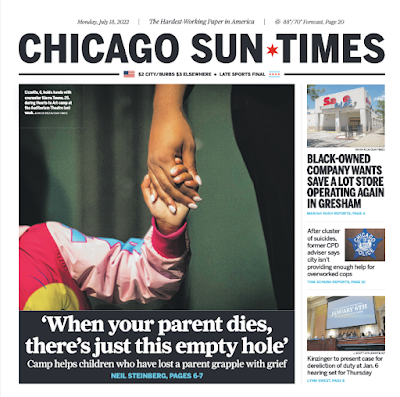The Groupon Building is at 600 West Chicago Avenue. North and west of Union Station. So when the cab I jumped into Friday morning immediately proceeded south and east, I immediately wondered if he knew where he was going. Cabbies sometimes don't. First day on the job perhaps.
I kept quiet, for an uneasy moment, then repeated, slowly, clearly, "600 West Chicago Avenue." He laughingly explained that this little dogleg was faster, and he was eager to get back to Union Station quickly to catch those arriving on the 9:25. We had a good conversation about cabbies, and passengers, and the city.
When he arrived, he didn't turn left, onto Chicago Avenue, as I expected, but took me a little past and pulled over on Larrabee Street. I got out, and began to walk to the corner, and saw a view of the Montgomery Ward Building I had never seen before. Pictured above, from the southwest corner of the intersection of Chicago and Larrabee.
I kept quiet, for an uneasy moment, then repeated, slowly, clearly, "600 West Chicago Avenue." He laughingly explained that this little dogleg was faster, and he was eager to get back to Union Station quickly to catch those arriving on the 9:25. We had a good conversation about cabbies, and passengers, and the city.
When he arrived, he didn't turn left, onto Chicago Avenue, as I expected, but took me a little past and pulled over on Larrabee Street. I got out, and began to walk to the corner, and saw a view of the Montgomery Ward Building I had never seen before. Pictured above, from the southwest corner of the intersection of Chicago and Larrabee.
Up to that point, I usually saw the statue in profile, from the west, driving down Chicago Avenue into downtown. It looked like a figure brandishing a horn. Somehow, because it was on the Montgomery Ward Building, I assumed it was the Angel Moroni, with his trumpet, because ... ah ... Montgomery Ward was a Mormon, perhaps.
Wrong. Ward wasn't a Mormon. Coming from an unfamiliar angle, I could see it wasn't a trumpet, but some kind of caduceus, a wand entwined with snakes. The statue, I quickly found out, is the Spirit of Progress, placed atop the building in 1929.
Rather than focus on my error — a reminder that no matter how much you know there is always much more you don't know — let's zero in on that caduceus. The only reason the ancient wand-like object isn't completely obscure is that the U.S. Army Medical Corps adopted it as its symbol in 1902, leading to its being picked up by the American Medical Association adopted it as the group's symbol, on its way to becoming representative of all things medical.
So what is it doing on a statue above a purveyor of dry goods?
Turns out, in addition to being the staff of Hermes, the God of Messengers, it is also associated with merchants, which makes sense, since they, like messengers, also travel to conduct their business. This economic usage is widespread enough that some doctors and medical organizations shun the caduceus as tainting the purity of their calling with the stink of commerce. Giving away the game. In closing, will I be needlessly provocative if I draw your attention to the photo below, and observe that it is an ugly statue, too big for its perch, that right arm wrapped weirdly around the torch?













